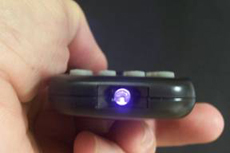Abstract

While the eye is not sensitive to infrared radiation, many cell phone cameras, web cameras and inexpensive video cameras can image infrared light that is near the edge of visible.
This is one of three related demonstrations:
1) Near IR on a Camera: IR with wavelength slightly longer than visible light.
2) IR on a Modified Webcam: Extending the rage of the webcam.
3) Thermal Camera: Can see the “glow” of objects around room temperature.
Portable
Yes
Principles Illustrated
Infrared radiation, use of IR LEDs, transmission of infrared, electromagnetic spectrum.
NCEA & Science Curriculum
JNR SCI, SCI 1.3, PHYS 1.4, PHYS 2.3, PHYS 3.5, SCI 3.6.
Instructions
Many devices use near infrared remote controls, and cameras with night lights  may also use IR emitters. These devices employ an infra red LED. Alternatively buy a IR LED from an electronics store(cost me $1.80 from a local store). The circuit shown in the Human Eye Resolution works well and allows a second LED. Many digital, video phone and web cameras are sensitive to near infra red and so can “see” the LED when it is working. Use a camera to view a remote control while it is being activated. Some remote controls have covers which appear to black plastic. In these remotes the plastic cover allows the transmission of IR. What other substances would transmit or absorb the IR produced by these LEDs? If a substance allows the transmission of visible light, will it also allow near IR to be pass through?
may also use IR emitters. These devices employ an infra red LED. Alternatively buy a IR LED from an electronics store(cost me $1.80 from a local store). The circuit shown in the Human Eye Resolution works well and allows a second LED. Many digital, video phone and web cameras are sensitive to near infra red and so can “see” the LED when it is working. Use a camera to view a remote control while it is being activated. Some remote controls have covers which appear to black plastic. In these remotes the plastic cover allows the transmission of IR. What other substances would transmit or absorb the IR produced by these LEDs? If a substance allows the transmission of visible light, will it also allow near IR to be pass through?
Safety
Individual teachers are responsible for safety in their own classes. Even familiar demonstrations should be practised and safety-checked by individual teachers before they are used in a classroom.
Related Resources
Infrared on a Webcam | Thermal Camera
Teaching Resources
Would you like to contribute lesson suggestions? Contact us.
Credits
This teaching resource was developed in collaboration with Rory O’Keeffe, a New Zealand Science, Mathematics and Technology Teacher Fellow, 2007, hosted by Victoria University School of Chemical and Physical Sciences. Rory is a science teacher by training and was Deputy Principal at Lytton High School in Gisborne, New Zealand. He is also an amateur astronomer. See NZSMT Teacher Fellowships for more information about the Teacher Fellow Programme.
This teaching resource was developed with support from
The MacDiarmid Institute
Faculty of Science, Victoria University of Wellington
School of Chemical and Physical Sciences, Victoria University of Wellington